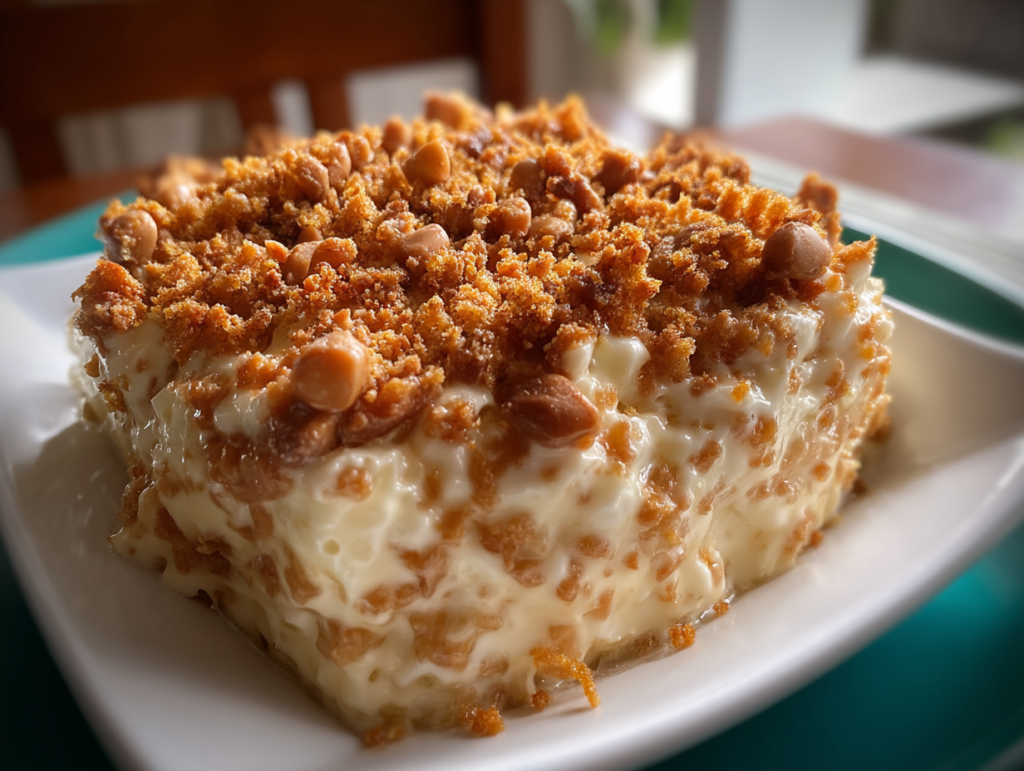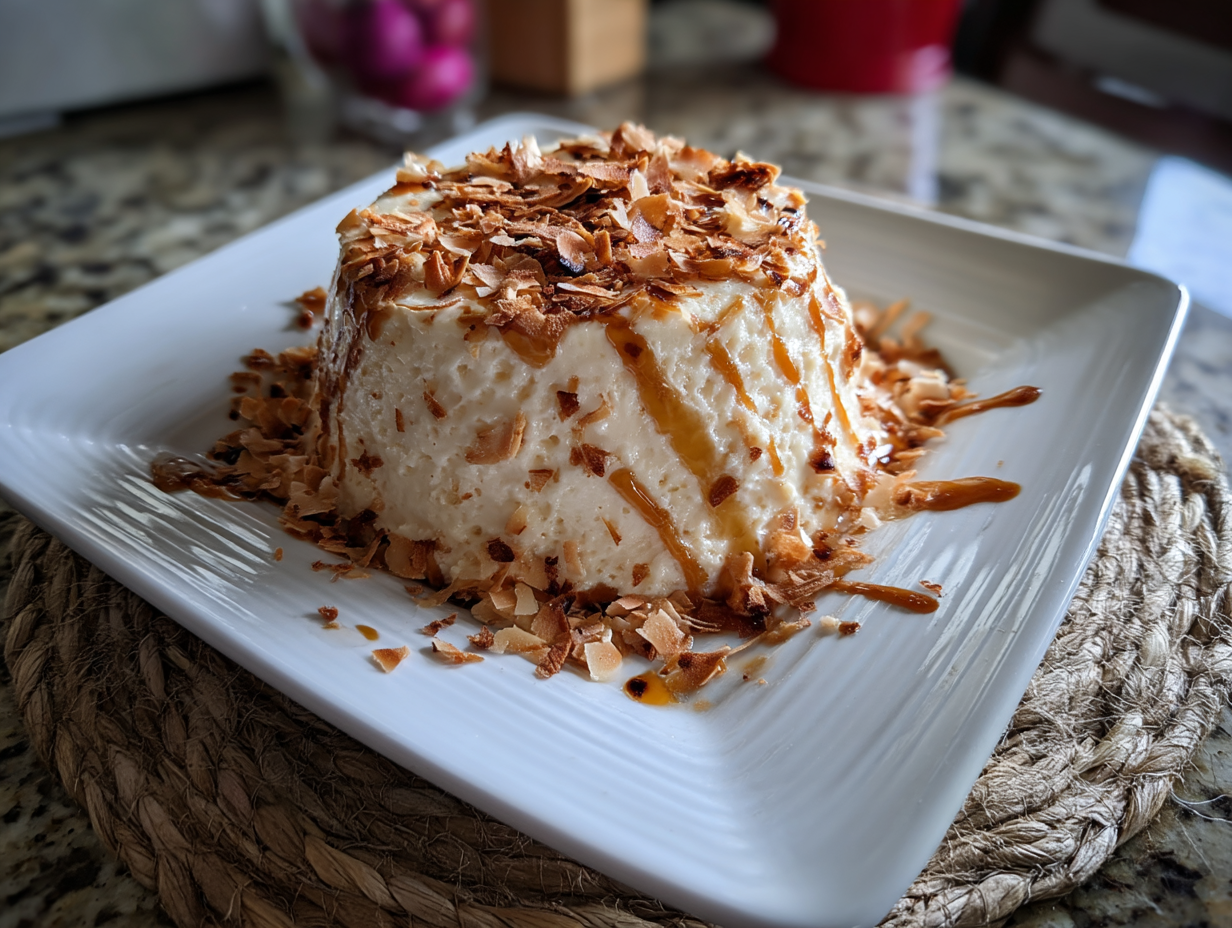Table of Contents
If you’ve ever been to a Filipino fiesta, you’ve likely seen Maja Blanca—a creamy, coconut-based dessert topped with latik or toasted coconut flakes. This beloved treat is a staple in Filipino cuisine, loved for its simplicity, rich flavor, and cultural significance.
In this article, we’ll guide you through everything about the Maja Blanca recipe, from its origins to step-by-step instructions. Whether you’re a beginner or a pro, you’ll master this Filipino dessert in no time. Let’s get started!
Introduction to Maja Blanca
What is Maja Blanca?
Maja Blanca is a traditional Filipino dessert made primarily from coconut milk, cornstarch, and sugar. Often referred to as coconut pudding, it has a smooth, jelly-like texture that melts in your mouth. The addition of corn kernels gives it a subtle crunch, making it a delightful contrast of creamy and chewy.
This dessert is a star at Filipino gatherings, from birthdays to Christmas celebrations. Its name, which translates to “white delicacy” in Spanish, reflects its colonial roots and the influence of Spanish cuisine on Filipino culture. Despite its fancy name, the Maja Blanca recipe is surprisingly simple, requiring only a handful of ingredients and minimal effort.
Why You Should Try This Maja Blanca Recipe
If you’re looking for a dessert that’s both easy to make and universally loved, Maja Blanca is the way to go. Its creamy texture and sweet, coconutty flavor make it a hit with both kids and adults. Plus, it’s incredibly versatile—you can customize it with different toppings or flavors to suit your taste.
What’s more, the Maja Blanca recipe is a great introduction to Filipino cuisine. It’s a dish that tells a story, one that’s deeply rooted in the country’s history and culture. By making it at home, you’re not just preparing a dessert; you’re keeping a tradition alive.
So, whether you’re craving something sweet or looking to impress your guests, this Maja Blanca recipe is sure to hit the spot. Stay tuned as we explore the essential ingredients and step-by-step instructions in the next parts!
Essential Ingredients for Maja Blanca
Core Ingredients for the Perfect Maja Blanca

When it comes to the Maja Blanca recipe, simplicity is key. The dessert relies on just a few core ingredients, each playing a crucial role in creating its signature texture and flavor. Here’s what you’ll need:
- Coconut Milk: This is the star of the show, giving Maja Blanca its rich, creamy base. Opt for fresh coconut milk if possible, but canned versions work just as well.
- Cornstarch: Acting as the thickening agent, cornstarch ensures the dessert sets properly. It’s what gives Maja Blanca its smooth, jelly-like consistency.
- Sugar: Sweetness is essential, and granulated sugar is the go-to choice. Adjust the amount based on your preference.
- Corn Kernels: These add a delightful crunch and a touch of sweetness, balancing the creaminess of the coconut milk.
Additionally, you can elevate your Maja Blanca recipe with optional ingredients like latik (toasted coconut curds) or toasted coconut flakes for garnish. These not only add flavor but also a beautiful contrast in texture.
Substitutes for Common Ingredients
Don’t have all the ingredients on hand? No worries! The Maja Blanca recipe is quite forgiving. Here are some handy substitutes:
- Instead of Cornstarch: If you’re out of cornstarch, try using rice flour or agar-agar. Both work well as thickening agents, though the texture might vary slightly.
- Instead of Coconut Milk: For a lighter version, you can use evaporated milk or even almond milk. However, keep in mind that this will alter the traditional flavor.
- Instead of Sugar: Honey or condensed milk can be used as sweeteners, though they’ll add their own unique flavors to the dessert.
By understanding these substitutions, you can still whip up a delicious Maja Blanca even if you’re missing an ingredient or two.
Step-by-Step Maja Blanca Recipe
Preparing Your Ingredients
Before diving into the cooking process, it’s important to get everything ready. Measure out your coconut milk, cornstarch, sugar, and corn kernels beforehand. This not only saves time but also ensures a smooth cooking experience.
Pro tip: Mix the cornstarch with a small amount of water to create a slurry. This prevents lumps from forming when you add it to the coconut milk later.
Cooking the Maja Blanca Mixture
- Heat the Coconut Milk: Pour the coconut milk into a saucepan and heat it over medium heat. Stir occasionally to prevent it from sticking to the bottom.
- Add the Sugar: Once the coconut milk is warm, gradually add the sugar. Stir until it’s completely dissolved.
- Incorporate the Cornstarch Slurry: Slowly pour the cornstarch mixture into the saucepan, stirring continuously. This is crucial to avoid lumps and achieve a smooth consistency.
Keep stirring until the mixture thickens. You’ll know it’s ready when it coats the back of a spoon and has a pudding-like texture.
Adding the Corn Kernels and Sweetness
Once the mixture has thickened, it’s time to add the corn kernels. Stir them in gently, ensuring they’re evenly distributed. If you prefer a sweeter dessert, you can add a bit more sugar at this stage.
Setting the Maja Blanca

- Pour into Molds: Transfer the mixture into a greased mold or baking dish. Smooth the top with a spatula for an even finish.
- Let It Cool: Allow the Maja Blanca to cool at room temperature for about 30 minutes.
- Refrigerate: Once cooled, place it in the refrigerator for at least 2 hours to set completely.
When it’s ready, your Maja Blanca should be firm yet creamy, with a beautiful glossy finish. Top it with latik or toasted coconut flakes for an extra touch of flavor and texture.
Tips and Tricks for Perfecting Your Maja Blanca
Common Mistakes to Avoid
Even though the Maja Blanca recipe is relatively simple, there are a few pitfalls to watch out for. Here’s how to avoid them:
- Lumpy Texture: If you don’t mix the cornstarch properly, you might end up with lumps. To prevent this, always create a slurry by mixing cornstarch with water before adding it to the coconut milk.
- Not Setting Properly: If your Maja Blanca doesn’t set, it could be due to insufficient cornstarch or not cooking the mixture long enough. Make sure to follow the measurements and cooking times closely.
- Overcooking: Overcooking can cause the mixture to become too thick or rubbery. Remove it from the heat as soon as it reaches a pudding-like consistency.
By keeping these tips in mind, you’ll be able to create a flawless Maja Blanca every time.
Creative Variations of Maja Blanca
One of the best things about the Maja Blanca recipe is its versatility. Here are some fun twists you can try:
- Ube Maja Blanca: Add ube (purple yam) extract or powder to the mixture for a vibrant purple hue and a unique flavor.
- Pandan Maja Blanca: Incorporate pandan leaves or extract for a fragrant, slightly nutty taste.
- Vegan Version: Use plant-based milk and a vegan sweetener to make a dairy-free version of this dessert.
- Gluten-Free Option: Stick to cornstarch or use rice flour to keep it gluten-free.
These variations allow you to experiment and tailor the dessert to your preferences.
Serving and Storing Maja Blanca
How to Serve Maja Blanca
Once your Maja Blanca is set, it’s time to serve it up! Here are some ideas:
- Traditional Style: Top it with latik (toasted coconut curds) or toasted coconut flakes for a classic touch.
- Fruit Toppings: Add fresh mango slices or a drizzle of mango puree for a fruity twist.
- Party Platter: Cut the Maja Blanca into small squares and serve it as bite-sized treats at parties.
No matter how you serve it, this dessert is sure to impress your guests.
Storing and Preserving Maja Blanca
If you have leftovers (which is rare!), here’s how to store them:
- Refrigeration: Keep the Maja Blanca in an airtight container in the fridge. It will stay fresh for up to 3 days.
- Freezing: While you can freeze it, the texture might change slightly upon thawing. If you do freeze it, wrap it tightly in plastic wrap to prevent freezer burn.
For the best taste and texture, enjoy your Maja Blanca within a day or two of making it.
FAQs About Maja Blanca
What Are Maja Blanca’s Ingredients?
The Maja Blanca recipe calls for just a few simple ingredients: coconut milk, cornstarch, sugar, and corn kernels. These are the basics, but you can also add toppings like latik or toasted coconut flakes for extra flavor and texture.
Why Didn’t My Maja Blanca Set?
If your Maja Blanca didn’t set, it’s likely due to one of two reasons: either you didn’t use enough cornstarch, or the mixture wasn’t cooked long enough. To fix this, make sure to follow the measurements closely and cook the mixture until it thickens to a pudding-like consistency.
What Can I Use Instead of Cornstarch in Making Maja Blanca?
If you’re out of cornstarch, don’t worry! You can use rice flour or agar-agar as substitutes. Both work well as thickening agents, though the texture might be slightly different. Just adjust the quantity as needed.
What Does Maja Blanca Mean in Spanish?
The name Maja Blanca translates to “white delicacy” in Spanish. It reflects the dessert’s colonial roots and the influence of Spanish cuisine on Filipino culture. Despite its fancy name, the Maja Blanca recipe is wonderfully simple and accessible.
Part 7: Conclusion
Why Maja Blanca Is a Must-Try Dessert
The Maja Blanca recipe is more than just a dessert—it’s a celebration of Filipino culture and tradition. Its creamy texture, sweet flavor, and versatility make it a favorite at gatherings and special occasions. Plus, it’s incredibly easy to make, even for beginners.
Whether you stick to the classic recipe or try one of the creative variations, Maja Blanca is sure to delight your taste buds. So, why not give it a try? Whip up a batch today and experience the magic of this beloved Filipino dessert.
Part 8: Exploring the Cultural Significance of Maja Blanca
Maja Blanca in Filipino Celebrations
The Maja Blanca recipe isn’t just a dessert—it’s a symbol of joy and togetherness in Filipino culture. Often served during fiestas, birthdays, and holidays like Christmas, this creamy treat brings people together. Its presence on the table signifies celebration and abundance, making it a must-have at any gathering.
Interestingly, Maja Blanca is also a popular offering during All Saints’ Day and All Souls’ Day. Families prepare it as part of their atang (offerings) to honor their departed loved ones. This tradition highlights the dessert’s deep cultural roots and its role in Filipino customs.
How Maja Blanca Reflects Filipino Ingenuity
The simplicity of the Maja Blanca recipe reflects the resourcefulness of Filipino cooking. With just a few basic ingredients, it transforms into a dessert that’s both elegant and satisfying. This ingenuity is a hallmark of Filipino cuisine, where humble ingredients are turned into something extraordinary.
Moreover, the dessert’s adaptability—whether through variations like ube or pandan—showcases the creativity of Filipino cooks. It’s a testament to how traditional recipes can evolve while staying true to their origins.
Part 9: Sharing the Joy of Maja Blanca
Why You Should Share This Recipe
The Maja Blanca recipe is more than just a dish—it’s an experience worth sharing. Whether you’re introducing it to friends who’ve never tried Filipino food or passing it down to the next generation, this dessert has a way of creating lasting memories.
Sharing the recipe also keeps the tradition alive. By teaching others how to make Maja Blanca, you’re preserving a piece of Filipino heritage. Plus, it’s a great way to bond with loved ones over a shared love of food.
Tips for Hosting a Maja Blanca-Themed Gathering
Why not take your love for Maja Blanca to the next level by hosting a themed gathering? Here are some fun ideas:
- Dessert Bar: Set up a DIY Maja Blanca station with different toppings like latik, toasted coconut flakes, and fresh fruits.
- Cultural Night: Pair the dessert with other Filipino favorites like lumpia (spring rolls) and pancit (noodles) for a full cultural experience.
- Recipe Swap: Invite friends to bring their own versions of Maja Blanca and share tips for perfecting the recipe.
By making Maja Blanca the centerpiece of your event, you’re not just serving dessert—you’re creating an unforgettable experience.

